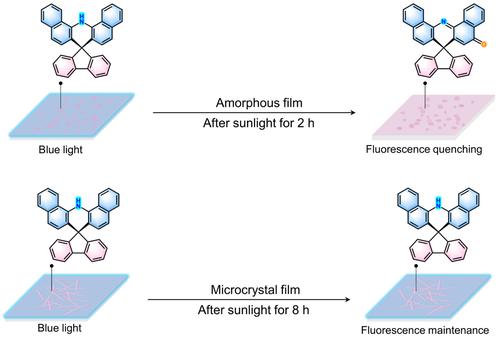当前位置:
X-MOL 学术
›
Chin. J. Chem.
›
论文详情
Our official English website, www.x-mol.net, welcomes your
feedback! (Note: you will need to create a separate account there.)
“Steric Armor” Strategy of Blue Fluorescent Emitters against Photooxidation-Induced Degradation
Chinese Journal of Chemistry ( IF 5.5 ) Pub Date : 2024-02-06 , DOI: 10.1002/cjoc.202300638 Sha‐Sha Wang 1 , Jing‐Rui Zhang 1 , Kuan‐De Wang 1 , Hao‐Ran Li 1 , Peng‐Hui Meng 1 , Yang Zhou 1 , Xiang Yu 1 , Ying Wei 1 , Quan‐You Feng 1 , Yu‐He Kan 2 , Ling‐Hai Xie 1
Chinese Journal of Chemistry ( IF 5.5 ) Pub Date : 2024-02-06 , DOI: 10.1002/cjoc.202300638 Sha‐Sha Wang 1 , Jing‐Rui Zhang 1 , Kuan‐De Wang 1 , Hao‐Ran Li 1 , Peng‐Hui Meng 1 , Yang Zhou 1 , Xiang Yu 1 , Ying Wei 1 , Quan‐You Feng 1 , Yu‐He Kan 2 , Ling‐Hai Xie 1
Affiliation

|
Stability against oxygen is an important factor affecting the performance of organic semiconductor devices. Improving photooxidation stability can prolong the service life of the device and maintain the mechanical and photoelectric properties of the device. Generally, various encapsulation methods from molecular structure to macroscopic device level are used to improve photooxidation stability. Here, we adopted a crystallization strategy to allow 14H-spiro[dibenzo[c,h]acridine-7,9′-fluorene] (SFDBA) to pack tightly to resist fluorescence decay caused by oxidation. In this case, the inert group of SFDBA acts as a “steric armor”, protecting the photosensitive group from being attacked by oxygen. Therefore, compared with the fluorescence quenching of SFDBA powder under 2 h of sunlight, SFDBA crystal can maintain its fluorescence emission for more than 8 h under the same conditions. Furthermore, the photoluminescence quantum yields (PLQYs) of the crystalline film is 327% higher than that of the amorphous film. It shows that the crystallization strategy is an effective method to resist oxidation.

中文翻译:

蓝色荧光发射体对抗光氧化诱导降解的“空间装甲”策略
对氧的稳定性是影响有机半导体器件性能的重要因素。提高光氧化稳定性可以延长器件的使用寿命,保持器件的机械和光电性能。通常,从分子结构到宏观器件水平的各种封装方法被用来提高光氧化稳定性。在这里,我们采用结晶策略,使 14 H-螺[二苯并[ c , h ]吖啶-7,9'-芴](SFDBA)紧密堆积,以抵抗氧化引起的荧光衰减。在这种情况下,SFDBA的惰性基团充当“空间装甲”,保护感光基团免受氧气的攻击。因此,与SFDBA粉末在阳光下2 h的荧光猝灭相比,SFDBA晶体在相同条件下可以保持其荧光发射8 h以上。此外,晶体薄膜的光致发光量子产率(PLQY)比非晶薄膜高327%。这表明结晶策略是一种有效的抗氧化方法。
更新日期:2024-02-06

中文翻译:

蓝色荧光发射体对抗光氧化诱导降解的“空间装甲”策略
对氧的稳定性是影响有机半导体器件性能的重要因素。提高光氧化稳定性可以延长器件的使用寿命,保持器件的机械和光电性能。通常,从分子结构到宏观器件水平的各种封装方法被用来提高光氧化稳定性。在这里,我们采用结晶策略,使 14 H-螺[二苯并[ c , h ]吖啶-7,9'-芴](SFDBA)紧密堆积,以抵抗氧化引起的荧光衰减。在这种情况下,SFDBA的惰性基团充当“空间装甲”,保护感光基团免受氧气的攻击。因此,与SFDBA粉末在阳光下2 h的荧光猝灭相比,SFDBA晶体在相同条件下可以保持其荧光发射8 h以上。此外,晶体薄膜的光致发光量子产率(PLQY)比非晶薄膜高327%。这表明结晶策略是一种有效的抗氧化方法。
































 京公网安备 11010802027423号
京公网安备 11010802027423号